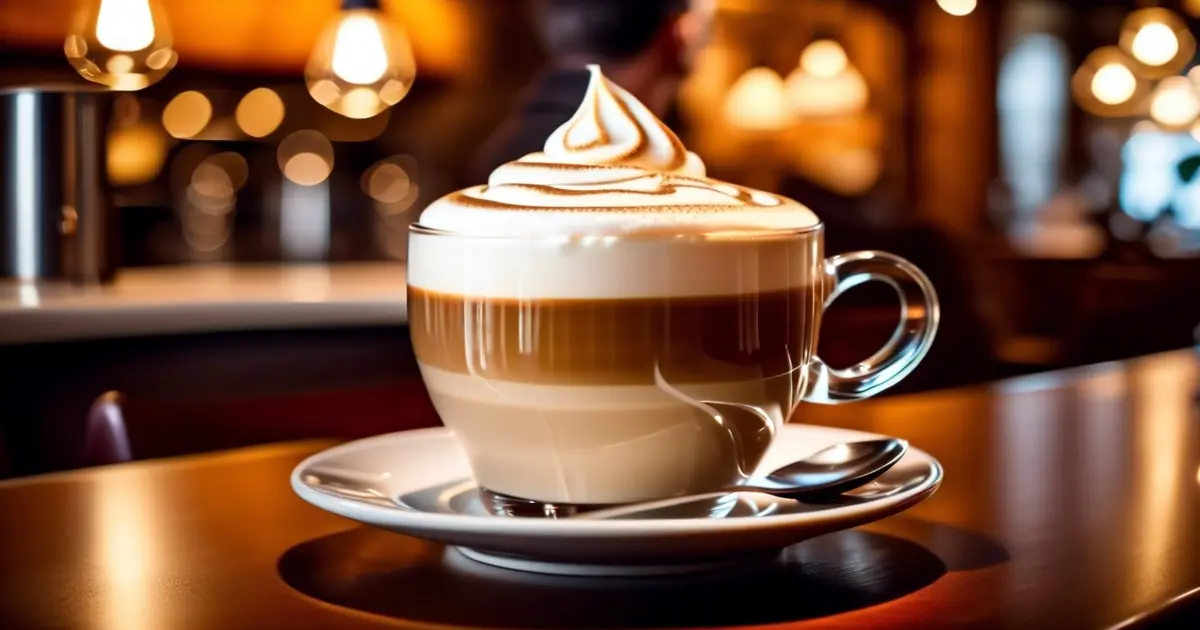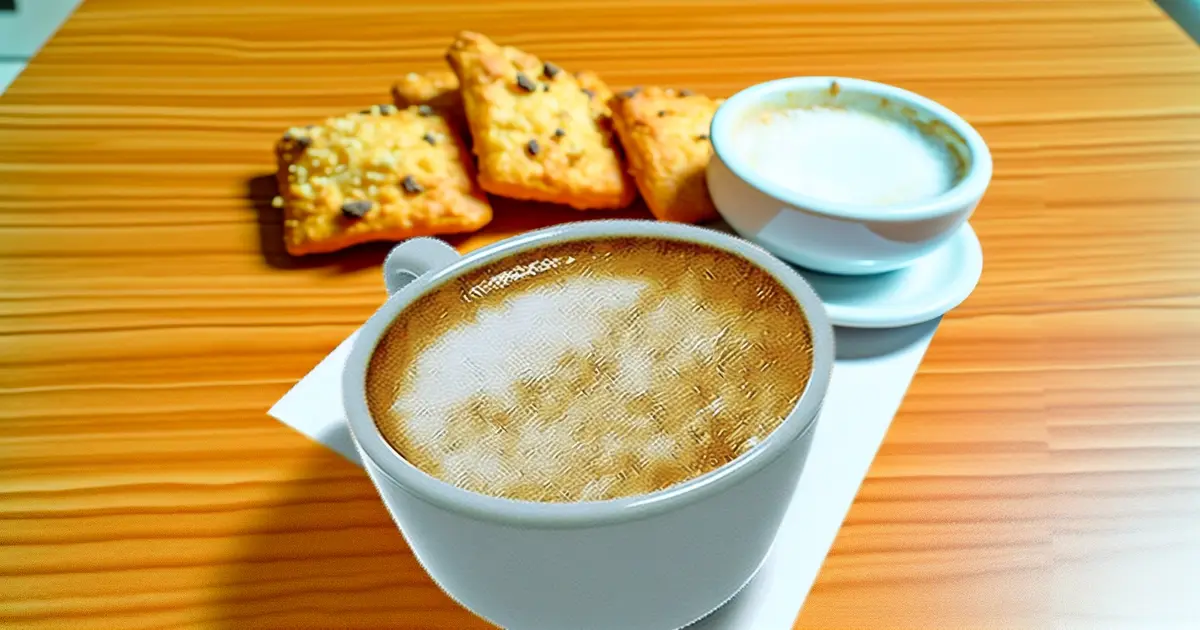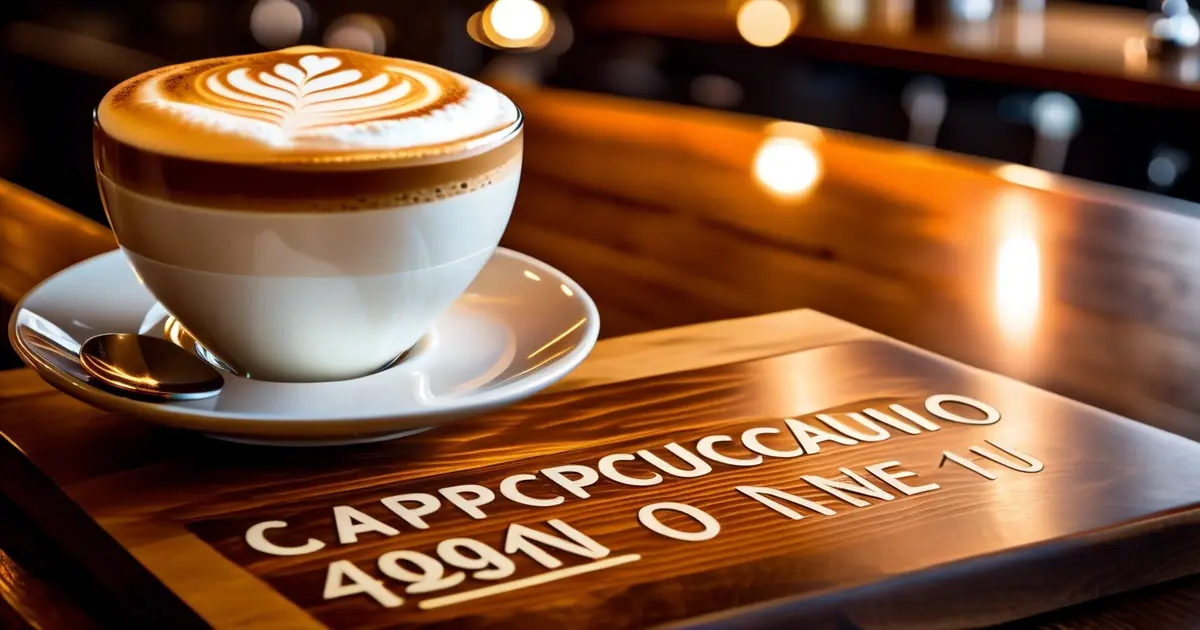Cappuccino: A Complete Guide to Making the Perfect Coffee
Master the art of making the perfect cappuccino with our comprehensive guide. Learn the secrets to brewing a delicious cup of this popular coffee beverage.

Did you know that cappuccino, made with part milk, is America's second most popular coffee drink, after lattes? This beloved Italian creation, straight espresso, has won the hearts of coffee lovers globally with its robust flavor and flavors. Made with a perfect harmony of espresso, steamed milk, and a velvety layer of frothed milk on top, cappuccinos are renowned for their rich flavor and creamy texture. Whether sipping a well-crafted coffee beverage at a cozy cafe or whipping it up at home, nothing quite compares to the indulgent experience of enjoying a flavorsome cap. In this post, we'll delve into the art of making the perfect cappuccino and explore how adding a sprinkle of cinnamon can elevate its taste to new heights with flavors.
- Origins and History of Cappuccino
- Defining the Classic Cappuccino
- Ingredients and Variations of Cappuccino
- Cappuccino vs. Espresso vs. Latte
- The Art of Cappuccino Foam and Latte Art
- Step-by-Step Guide to Making a Cappuccino at Home with froth milk and straight espresso.
- Selecting the Best Milk for Your Cappuccino
- Understanding Cappuccino's Caffeine and Calories
- Tips for Mastering Homemade Cappuccino
- Conclusion
- Frequently Asked Questions
- What is the origin of cappuccino?
- How does cappuccino differ from espresso and latte?
- Can I make a cappuccino at home without an espresso machine using different brewing methods and froth milk to create the coffee beverage with foamed milk?
- Which type of milk is best for making cappuccinos?
- How much caffeine does a typical cappuccino contain?
Origins and History of Cappuccino
19th Century Documentation
The cappuccino flavors we enjoy today have a rich history that dates back to the 17th century in Italy. However, it is interesting to note that evidence of a coffee drink mixed with milk called cappuccino and flavors already existed in Central Italy during the 19th century. This fact adds intriguing flavors to the evolution of this beloved beverage.
This documentation from the 19th century sheds light on how cappuccino was already part of Italian coffee culture before its modern iteration gained popularity. The existence of this earlier version underscores the enduring nature of cappuccino as a staple in Italian coffee traditions.
Name and Inspiration
Named after the distinctive brown hooded robes of Capuchin friars, cappuccino reflects an exciting blend of cultural influence and inspiration. These robes were known as "cappuccio," which translates to "hood" or "little hood." The color and texture resemblance between these robes and a perfectly prepared cappuccino inspired its name.
The connection between the attire worn by Capuchin friars and the appearance of a well-prepared cappuccino adds depth to its origins. It highlights how historical elements intertwine with culinary creations, shaping flavors and names.
Defining the Classic Cappuccino
Crafting a Cappuccino
Crafting a cappuccino is an art that involves achieving the perfect balance of flavors and textures. This classic Italian coffee beverage has three key components: espresso, steamed, and frothed milk. Each element is crucial in creating the signature taste and velvety texture that defines a well-made cappuccino.
To begin with, the foundation of a cappuccino is its rich and robust espresso base. This concentrated coffee shot provides the bold flavor profile essential to this beloved drink. It's important to note that the ideal ratio for crafting a traditional cappuccino is 1/3 espresso, ensuring it delivers just the right amount of intensity without overpowering the other elements.
Moving on to another vital component, we have steamed milk. This silky smooth addition complements the espresso's boldness and adds creaminess to the overall texture. When preparing this beverage, achieving precisely 1/3 steamed milk ensures that it harmonizes seamlessly with the espresso and frothed milk, resulting in an indulgent yet perfectly balanced blend.
Lastly, we cannot overlook one of the most distinctive features of a cappuccino - its luxurious layer of dense and airy foam known as frothed milk. This element in equal measure (1/3 frothed milk) completes this delightful concoction by imparting an exquisite creamy texture and an aesthetically pleasing finish.
In essence, mastering these ratios allows baristas or enthusiasts at home to create an authentic cappuccino experience reminiscent of Italy's iconic cafes.
Traditional Serving Size
The traditional serving size for a classic cappuccino typically amounts to around 6 ounces. This modest portion showcases respect for simplicity and emphasizes savoring every sip without overwhelming oneself with excess volume.
Interestingly enough, before its introduction outside Italy in the 1930s, where it was relatively unknown beyond Italian borders, today's widespread appreciation for this timeless beverage reflects how something so quintessentially Italian has transcended cultural boundaries worldwide.
Ingredients and Variations of Cappuccino
Main Ingredients
A classic cappuccino has three main ingredients: espresso, milk, and foam. The espresso, a strong coffee made by forcing hot water through finely ground coffee beans, forms the base of the cappuccino. It provides the rich, bold flavor that characterizes this beloved beverage. Then comes the milk, steamed to create a velvety texture and sweet taste. Lastly, foam tops off the cappuccino, adding a light and airy layer that enhances the visual appeal and overall experience.
In addition to these core components, some variations call for different types of milk, such as almond or oat milk, for those who are lactose intolerant or prefer plant-based options. These alternatives can infuse unique flavors into the drink while catering to dietary preferences.
Flavorful Variations
Various additions can be incorporated to cater to different tastes and preferences. For instance, flavored syrups like vanilla or caramel are commonly used to add sweetness and depth to the traditional cappuccino. These syrups enhance the taste and offer a delightful aroma that complements the coffee's robustness.
Moreover, chocolate sprinkles or cinnamon dusting can be sprinkled on top of a cappuccino for an extra indulgence. This adds an element of decadence without overpowering the delicate balance between coffee and dairy elements in this classic drink.
Regional Variations
Beyond individual preferences in flavorings lies regional diversity in cappuccino preparation across different parts of the world. In Vienna, Austria, for example, they have their unique twist on this beloved beverage, Viennese cappuccino with whipped cream instead of foam topping - offering an even richer experience with its luxurious creamy texture.
Similarly, where this iconic drink originated in Italy, there's "Caffè Marocchino," which involves adding cocoa powder mixed with frothed milk before adding espresso - giving it an entirely new dimension compared to traditional recipes.
Cappuccino vs. Espresso vs. Latte
Cappuccino
Cappuccino, a popular coffee beverage, consists of equal parts espresso, steamed, and frothed milk. This creates a delightful balance of intense coffee flavor, creamy steamed milk, and airy foam. The equal distribution of these elements gives the cappuccino its unique taste and texture.
Cappuccinos are known for their rich, bold flavor derived from the espresso. The straight espresso is a concentrated shot of black coffee without any added milk or water. Combined with perfectly steamed milk and velvety foam in equal proportions, it results in an indulgent yet well-balanced drink.
The art of creating the perfect cappuccino lies in achieving the ideal harmony between the espresso's robustness, steamed milk's creaminess, and frothed milk's lightness.
Espresso
Espresso is often favored by those who appreciate intense coffee flavors without dilution from added ingredients like sugar or cream. Concentrated black coffee packs a powerful punch due to its brewing process using high-pressure and finely ground coffee beans.
In contrast to other popular coffees like lattes or cappuccinos containing varying amounts of dairy products, espresso is a pure expression of coffee's inherent richness and depth.
Compared to cappuccinos that blend equal parts espresso with steamed and frothed milk to create a harmonious balance between bitterness and sweetness, espressos cater exclusively to lovers of unadulterated black coffee with no frills attached.
Latte
The latte has gained immense popularity since its inception in Italy during the 1980s when it became known as "caffè latte," translating to "milk coffee" in Italian. Unlike cappuccinos, where all three components share equal footing - espresso, steamed milk, and frothed milk; lattes feature more steamed than foamy textured microfoam on top. This difference makes lattes noticeably creamier than cappuccinos but lighter than flat whites due to their higher ratio of warm, silky smooth microfoam, giving them their characteristic velvet mouthfeel.
The Art of Cappuccino Foam and Latte Art
Textured Milk
To achieve the velvety texture essential for a perfect cappuccino, baristas must master steaming milk. The process involves heating milk while simultaneously injecting air to create microfoam. This delicate balance results in a creamy, velvety consistency without large bubbles.
Creating ideal foam is crucial as it significantly impacts the overall taste and mouthfeel of the cappuccino. When done correctly, the foam complements the rich flavor of espresso, adding a luxurious creaminess to each sip. By mastering this technique, baristas ensure that every cappuccino served meets high standards and provides an exceptional sensory experience for coffee enthusiasts.
Latte Art
Latte art represents one of the most captivating aspects of serving cappuccinos and lattes. It involves skillfully pouring steamed milk into espresso to craft intricate designs on the surface of these beloved beverages. From hearts and rosettas to tulips, these visually stunning creations enhance the drink's appearance and reflect a barista's dedication to their craft.
Producing beautiful latte art demands precision, creativity, and patience from baristas who pridefully present aesthetically pleasing beverages to customers. Each design is a testament to their expertise in coffee preparation techniques and artistic expression.
Step-by-Step Guide to Making a Cappuccino at Home with froth milk and straight espresso.
Fresh Coffee Beans
To make a delicious cappuccino, start by grinding fresh coffee beans. The freshness of the beans significantly impacts the flavor of your espresso. Using freshly ground coffee ensures you capture all the aromatic oils and nuances.
When grinding your coffee, aim for a fine consistency similar to table salt. This texture allows for optimal extraction during brewing, resulting in a rich and flavorful shot of espresso.
Once you've ground your coffee to perfection, it's time to brew espresso. This can be done using an espresso machine or any method that produces concentrated coffee with high pressure, such as a Moka pot or AeroPress.
Brewing Methods:
- Espresso Machine
- Moka Pot
- AeroPress
Steaming Milk for Cappuccino
The next step is steaming milk to create that creamy and velvety texture essential for a delightful cappuccino experience. Heat the milk with either a frother or steam wand while introducing air to achieve that characteristic foam associated with cappuccinos.
Different Brewing Methods:
- Frother - Utilize an electric frother that simultaneously simplifies the process by heating and frothing milk.
- Steam Wand - Commonly found on espresso machines, it provides manual control over temperature and foam density.

Selecting the Best Milk for Your Cappuccino
Whole Milk
Whole milk is famous for making cappuccinos because of its creamy texture. Steaming produces thick and velvety foamed milk, producing a rich and indulgent cappuccino. The high-fat content in whole milk contributes to the luxurious mouthfeel and adds depth to the beverage's flavor profile.
Whole milk is known for creating a dense microfoam that holds its shape well, allowing baristas to craft intricate latte art on top of the cappuccino. The natural sweetness of whole milk also complements the robust flavor of espresso, balancing out any bitterness and enhancing the overall taste experience.
Using whole milk ensures that your homemade cappuccino closely resembles those served at specialty coffee shops, providing an authentic and satisfying indulgence without compromising on quality or taste.
Non-Dairy Alternatives
For individuals who prefer non-dairy options, several alternatives, such as almond, soy, or oat milk, can create delicious cappuccinos. These plant-based milks offer unique flavors and textures, catering to varying dietary preferences while delivering a delightful coffee experience.
Almond milk brings a subtle nuttiness to the cappuccino, while soy milk provides a creamy consistency with a slightly sweet undertone. Oat milk, on the other hand, offers a smooth and silky texture that enhances the overall mouthfeel of the beverage.
When selecting non-dairy alternatives for your cappuccino, consider experimenting with different brands and varieties to find one that best complements your preferred espresso blend. Each type of alternative milk interacts differently with espresso when steamed, impacting both taste and presentation.
Ultimately, whether you opt for traditional whole milk or explore non-dairy options like almond, soy, or oat milk depends on personal preference—each offering its distinct contribution to crafting an exceptional homemade cappuccino.
Understanding Cappuccino's Caffeine and Calories
Caffeine Content
A typical cappuccino contains about 150 milligrams of caffeine. This amount can vary depending on the size and number of espresso shots used in the drink. Caffeine content is essential, especially for individuals sensitive to caffeine or limiting their daily intake. e of this when you enjoy a cappuccino, especially if consumed later in the day.
Caffeine can affect the body, including increased alertness and improved concentration. However, excessive consumption can lead to restlessness, jitters, and difficulty sleeping. Therefore, individuals must be aware of their tolerance levels and make informed choices regarding caffeine intake.
Calorie Count
The calorie content of a cappuccino depends primarily on two factors: the size of the drink and the type of milk used. A standard 8-ounce cappuccino made with whole milk typically contains around 80 calories from the milk alone. However, larger sizes or additional flavorings like syrups can significantly increase this count.
Choosing low-fat or non-fat milk instead of whole milk reduces the calorie count without compromising taste. For instance, skimmed milk decreases fat content and overall calories while providing that creamy texture many enjoy in a cappuccino.

Tips for Mastering Homemade Cappuccino
Freshly Roasted Coffee Beans
When making a cappuccino, starting with the proper foundation - freshly roasted coffee beans- is crucial. The freshness of the beans significantly impacts the flavor profile of your cappuccino. Using freshly roasted beans ensures you capture all the nuanced flavors, producing a more aromatic and flavorful cup of coffee.
Freshly roasted coffee beans provide a richer, more complex taste than pre-ground ones.-- They are packed with volatile compounds contributing to your cappuccino's overall aroma and flavor. This step is essential for achieving a high-quality homemade cappuccino.
Experimenting with different ratios of espresso, steamed milk, and foam can help you customize your cappuccino according to your preferences.-- If you prefer a more robust coffee flavor, you should increase the ratio of espresso in your drink. On the other hand, adjusting the amount of steamed milk and foam would be beneficial if you enjoy a creamier texture from milk.
Frothing Milk Techniques
Frothing milk is an art that requires practice but yields rewarding results when mastered.-- Achieving velvety smooth microfoam is essential for creating an authentic cappuccino experience at home. By practicing frothing techniques using different types of milk (whole, 2%, almond), you can determine which produces the best microfoam you like.
The key lies in creating tiny bubbles within the milk while maintaining its creamy consistency.-- These tiny bubbles give your cappuccino its signature texture and mouthfeel. Mastering this technique lets you control how much air is incorporated into the milk, ensuring it complements your cappuccino's espresso flavor.
Conclusion
You've now uncovered the rich history, the artistry, and the science behind crafting the perfect cappuccino. With knowledge about its origins, ingredients, and variations, you can embark on your cappuccino-making journey. Whether you prefer a traditional Italian-style cappuccino or enjoy experimenting with unique flavors and latte art, the world of cappuccinos is yours to explore.
So, grab your favorite mug, steam some milk, pull a shot of espresso, and start creating your masterpiece. With practice and passion, you'll soon be sipping on a velvety-smooth, perfectly balanced cappuccino that rivals those from the best cafes. Cheers to your newfound expertise in the art of cappuccinos!
Frequently Asked Questions
What is the origin of cappuccino?
Cappuccino originated in Italy and was named after the Capuchin friars' brown robes due to their similar color. It evolved from Italian espresso with steamed milk and milk foam, creating a delightful balance of flavors.
How does cappuccino differ from espresso and latte?
A cappuccino consists of equal parts espresso, steamed milk, and milk foam, while an espresso is a concentrated shot of coffee. On the other hand, a latte contains more steamed milk and less foam than a cappuccino.
Can I make a cappuccino at home without an espresso machine using different brewing methods and froth milk to create the coffee beverage with foamed milk?
Yes! You can make a delicious homemade cappuccino using alternative methods like the French press or Moka pot for brewing strong coffee. Then, could you give your choice of milk to create that signature creamy texture?
Which type of milk is best for making cappuccinos?
Whole dairy milk is often preferred for creating rich and creamy microfoam essential for traditional cappuccinos. However, non-dairy options like oat or almond milk can also produce excellent results with their unique flavors.
How much caffeine does a typical cappuccino contain?
A standard 8 oz (240 ml) serving of cappuccino contains approximately 80 mg of caffeine. The ratio may vary based on the amount and strength of the espresso used in preparing the drink.